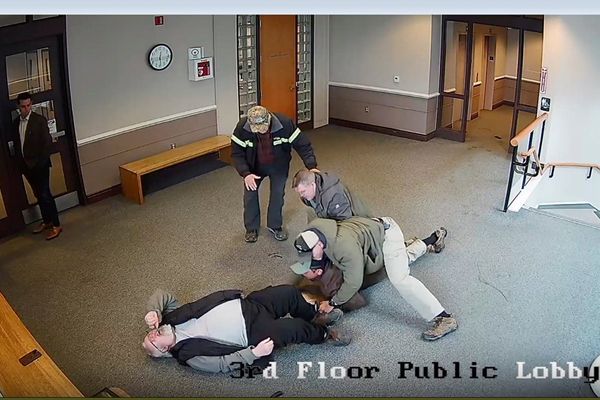
Pat Kelsey came running onto the court at the KFC Yum! Center, grabbing a whistle from a manager without slowing down and starting a vibrant one-hour walkthrough for his Louisville Cardinals. The opponent that night was the Wake Forest Demon Deacons. There was no time to waste.
It was 10:05 a.m. on Tuesday, Jan. 28, and Kelsey had spent a couple of days stewing over his zone offense, knowing Louisville would have to navigate Steve Forbes’s confusing and combative 1-3-1 defense. By Sunday night, Kelsey and his staff had scrapped their plan and started over, implementing a different attack for this game.
Kelsey put his players through a crash course on the new approach Monday, including a long film session. But there was plenty left to button up on Tuesday morning, with tip-off fewer than nine hours away. With his practice plan tucked into the front of his gray sweatpants, the 49-year-old Kelsey sprang into action as the starters lined up against the scout team’s 1-3-1.
“James,” Kelsey said to big man James Scott. “You are screening like a mofo.”
The 5' 9" (at best) Kelsey inserted himself for the 6' 11" Scott and went about the business of screening like a mofo—hitting the man at the top of the zone, hitting the wing, hitting the other wing—with cartoonish energy. If this were a pickup game at the Y, Kelsey would be the annoying opponent playing like Final Four berth was on the line.
The screen-like-a-mofo intent was to free up passing and driving lanes for point guard Chucky Hepburn, shooting windows for perimeter marksmen Reyne Smith and Terrence Edwards Jr., and the occasional backside lob for wing J’Vonne Hadley. The starting five absorbed the new plan quickly and carved up the scout team.
Kelsey then broke up the X’s and O’s session for a high-energy, high-volume shooting competition, music throbbing through the arena and everyone shouting encouragement. (Smith, second in the nation in made three-pointers with 91, swished so many consecutive wing threes that he started trying to bank them in for an added degree of difficulty.) After a silent foul-shooting session and a defensive segment focusing on Wake’s leading scorer, Hunter Sallis, peripatetic Pat called the team together at precisely 11:05 a.m. to end practice.

Anticipating a bruising game, much like the Duke Blue Devils’ slog against the Demon Deacons three days earlier, Kelsey called out the chant: “Rock fight on three!”
“One-two-three, rock fight!”
Before the players dispersed, Kelsey quietly recommended they stop by the small group sitting in the front row watching the walkthrough. He wanted them to pay their respects to the ACC Network broadcasters who would call the game that night.
“Jim Boeheim’s over there, for God’s sake,” Kelsey said, to himself as much as anyone else.
The idea that a man with more than 1,000 Division I victories, five Final Fours and a national title would come watch a Kelsey practice struck a reverential chord in the coach of the Cardinals. After a lengthy stay in the lower levels of Division I—nine years at Winthrop and three at Charleston—having Boeheim in the gym was another in a succession of welcome-to-the-big-time moments since arriving at Louisville last March.
“In 13 seasons, I’ve played two possessions of zone,” Kelsey said to Boeheim, the godfather of zone defense. “We gave up baskets on both of them.”
Modesty aside, Kelsey is trying to do something in his Louisville debut season that Boeheim did only once in 10 seasons of Atlantic Coast Conference membership with the Syracuse Orange—finish in the top two in the league. The Cardinals currently are in the hunt at 10–2, a half-game behind the Clemson Tigers and a game behind Duke. That includes a thorough beatdown of Wake Forest that January night in the Yum! Center, in which Louisville led by as many as 29 points before winning by 13. The retooled zone offense sliced up Wake’s 1-3-1, to the roaring approval of a renewed home environment.
At 18–6 overall, the Cardinals are all but locked into their first NCAA tournament berth since 2019. Coming off consecutive last-place ACC finishes, Louisville is the nation’s most improved power program.
Although Kelsey has turned out to be the best choice for this job, he was not the first choice. Athletic director Josh Heird points out Kelsey was the first candidate he spoke to, but serious overtures were made to Scott Drew of the Baylor Bears, Dusty May then of the Florida Atlantic Owls and Josh Schertz then of the Indiana State Sycamores.
Drew was always a long shot. May went well down the road with Louisville before opting for the Michigan Wolverines. Schertz might have gotten the job if Indiana State hadn’t lost the Missouri Valley Conference tournament final and been controversially left out of the NCAA tourney. Kelsey got Charleston into the Big Dance by winning the Coastal Athletic Association tournament for the second year in a row, then waited for Heird’s search to suss out.
It took a few anxious days to land definitively on Kelsey. Once there, it didn’t take long to finalize a deal.
“First conversation I had with him, he said, ‘I would crawl to this job,’ ” Heird recalls.
Upon arrival, Kelsey inherited an accomplished program but a difficult task. Louisville has won three national championships, but one was vacated due to NCAA sanctions and the place had been plagued by scandal and dysfunction for nearly a decade. Getting the Cardinals back in flight required tearing the place down to the studs and rebuilding on the fly.
Kelsey orchestrated a complete roster and staff overhaul, but at least he brought some continuity with him—three players and no fewer than 10 staffers joined his relocation from Charleston. This was a major step up for all of them, but Kelsey knew they were ready.

“I’m not saying I’m different, but not a lot of people go from mid-major to Power 5 and they take everybody,” he says. “I took everybody, including my strength coach, including our trainer, the operations guy, all that. So they know me. They eat, sleep, breathe, believe in what we do, our culture, the energy that we have, and they spread the message.”
The first message—the one a proud but downtrodden and divided fan base wanted to hear—was that effort, positive energy and respect for the program would be the foundation of the rebuild. Pretty basic stuff, but those elements were lost in two shockingly bad years under Kenny Payne. Fans accustomed to coaching and motivational excellence from Denny Crum and Rick Pitino watched Payne flounder on the sideline as his players coasted through the motions, bereft of passion. The two-year record: an inconceivable 12–52.
That all changed overnight. Louisville landed one big-name transfer (Hepburn from the Wisconsin Badgers), three important players from power-conference programs (Hadley from the Colorado Buffaloes, Noah Waterman from the BYU Cougars and Koren Johnson from the Washington Huskies), and a handful of players moving up from mid-major teams.
The disparate pieces have fit together remarkably well and remarkably quickly—November victories over the Indiana Hoosiers and West Virginia Mountaineers in the Bahamas outweighed a blowout loss there to the Tennessee Volunteers. When the Cardinals put up a 40-minute fight in a road loss \against the archrival Kentucky Wildcats, a clear return to competitiveness was at hand. And when that was followed by a 10-game winning streak that included seven double-digit ACC victories, it was time to set sights on a return to the NCAA tournament.
“It’s so difficult to knock it out of the park with a star and then knock it out of the park in the portal,” ESPN analyst Jimmy Dykes said. “He’s done that."
This turnaround has been accomplished amid a veritable injury plague. Impact players Kasean Pryor and Johnson were lost for the season in November. Waterman missed four games and was limited in others due to a broken thumb. Wing Aboubacar Traore, Louisville’s most athletic player, missed 10 games. Heading into a Wednesday road game against the North Carolina State Wolfpack, Scott (mouth injury) and—most importantly—Hepburn (groin) are question marks.
Through the attrition and lineup adjustments, Louisville has kept winning. Most importantly to the fans who had grown numb to the sight of the Cardinals faltering at the first sign of adversity, Louisville has kept trying.
“Going through those two years [under Payne], it just wasn’t fun,” Heird says. “None of it. And then being able to see it now and experience it, this is exciting. This is fun.”
It took a fire-starter. It took a disciple of a coach who died too young. It took a former player who would never admit he was too small. It took Pat Kelsey.
“Who’s your starting point guard? I’m going to kick his ass.”
That was Kelsey’s statement to the Wyoming Cowboys coaching staff when he arrived in Laramie, Wyo., in 1993 as a pugnacious freshman pipsqueak out of Cincinnati. Joby Wright was the first-year head coach who came from Miami (Ohio), where he had been recruiting Kelsey out of Elder High School. When Wright and his staff moved West, Kelsey followed.
Backing up his boast, Kelsey started 22 out of 28 games as a freshman on a 14–14 Wyoming team. (“We stunk, which is probably why I started,” he says.) He averaged just 2.3 points per game and made only 26.4% of his shots, but he did chip in 3.3 assists.
But one year was enough in Wyoming; afterward Kelsey transferred back home. He walked on with the Xavier Musketeers to play for the new head coach there, Skip Prosser, who had previously been an assistant there under Pete Gillen.
Kelsey’s playing time and production plummeted at Xavier, but he found a niche role for himself on a pair of NCAA tournament teams. He would be the best scout teamer, bench-mob guy and chemistry builder possible.
“For whatever reason, my shot just kind of got away from me as I got late in high school,” Kelsey says. “I did a lot of other things really well. Some people would say I couldn’t score in an empty gym, but I just tried to be a bulldog on defense, tried to be a catalyst off the bench and bring our team energy, fight anybody who wanted to fight, and just set the tone every day in practice.”

While sitting on the Xavier bench soaking up Prosserisms, Kesey found his life’s calling. He became an assistant at his high school, then joined his mentor’s staff at Wake Forest in 2004. He was at Prosser’s side, literally and figuratively, for the next four seasons. Until a sudden and terrible summer day in ’07.
Prosser went for a jog on July 26, came back to his office, lied down on his couch and died of a heart attack at age 56. Panic ensued when Prosser was found—911 called, paramedics responded and tried to revive him. Kelsey, trying to help however he could, moved their ambulance directly in front of the Wake Forest basketball offices, just in case they needed to rush Skip to the hospital.
It was too late. Prosser was gone, but he’s never been forgotten—not in the coaching profession, and certainly not by Kelsey. He quotes Prosser or refers to him not just daily, but almost hourly.
“Skip was a Renaissance man,” Kelsey says. “He was so interesting. He could talk hip hop and rap, he could talk high-level politics, he could talk Irish literature writers … his vocabulary was off the charts. He was so interesting. Some of my favorite times working for him were the times we went driving together recruiting and we would talk everything but basketball.
“He was a doting father. He loved his sons, he loved to read. He was a terrific basketball coach and probably his greatest attribute was he was a teacher—he was a phenomenal teacher. And unfortunately we lost him 17 years ago.”
Many Prosser staffers have gone on to become college head coaches. Among them: Chris Mack, Dino Gaudio, Mark Schmidt, Justin Gray and A.W. Hamilton. None are more fervent torchbearers for his legacy than Kelsey.
“Of all Skip’s assistants,” says ESPN analyst Fran Fraschilla, “he’s the closest thing to Skip.”
Kelsey internally pushed down his grief over Prosser’s death for years, immersing himself in his job while still at Wake working under Gaudio and then back at Xavier as an assistant to Mack. But intensity doesn’t necessarily promote healing. Finally, in 2011, it all came bubbling up in a debilitating way. He nearly quit the profession.
“Four years ago, I witnessed firsthand Coach Prosser’s death in the basketball office at Wake Forest,” Kelsey said in a statement in May 2011. “That day, my perspective on the profession and life was forever altered. My role as a father and husband is everything to me and the rigors of this business can make that challenging. My family and my health come first. I have allowed time to pass following the season to be sure of my decision. I am currently evaluating opportunities outside of coaching.”
After sitting out the 2011–12 season and getting counseling, Kelsey came back, landing the head coaching job at Winthrop. A high-level program in a low-level league, the Big South, the Eagles had slipped after a long run of dominance under Gregg Marshall. Kelsey revived those ways, reeling off eight straight winning seasons and earning the Big South tournament title three times.
Kelsey nearly left for Massachusetts in 2017, bailing out less than an hour before his introductory news conference and staying at Winthrop. As the years went by, he seemed increasingly overqualified for the job. When he finally left for Charleston, his successor at Winthrop was Mark Prosser, Skip’s son. It was a poignant passing of the torch.
“After Skip passed, he took a little bit of a sabbatical,” says Nancy Prosser, Skip’s widow. “I think he’s still affected by what happened to Skip. There’s not a better human being than Pat Kelsey.”
The post-walkthrough bull session with Boeheim and the rest of the ACC Network crew was over. Kelsey was standing on the Yum! Center court, 20,000 empty seats around him. He was asked a question: How ready was this fan base for what you could do, and how ready were you for this job?
Kelsey pivoted his body slightly to the right. He looked away. His voice grew soft and his eyes watery.
“It’s been a long journey,” he says. “I started in Division I coaching 22 years ago. Your path takes you where it’s going to take. At the end of the day, there’s really not a better situation, for me, in the entire country. Basketball really, really matters here.
“Skip used to say, never delay gratitude. I’m just blessed. I realize how lucky I am to be standing on that sideline that Denny Crum and Rick Pitino stood on. You know what I mean? It’s crazy. This is a town that takes so much pride in Louisville basketball, and I just think the city was hungry. They were kind of ready and the stars aligned. It all kind of came together at the right time.”
This article was originally published on www.si.com as How Pat Kelsey Revived Louisville Hoops and His Passion Along the Way.







